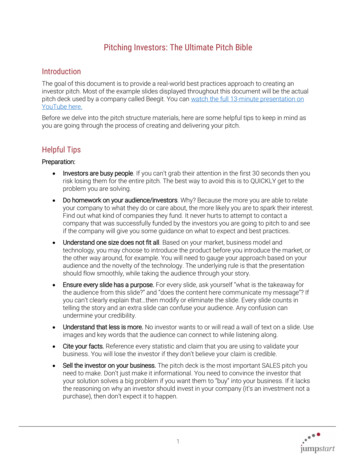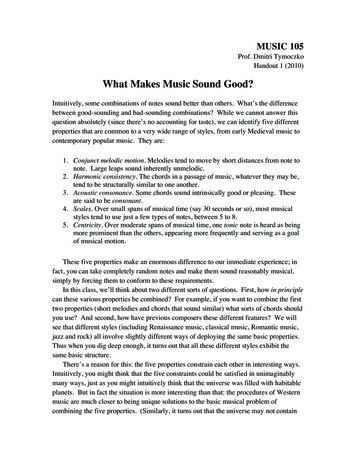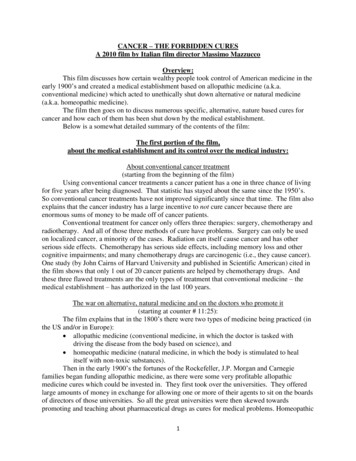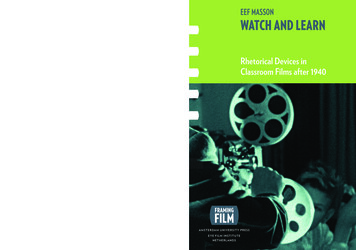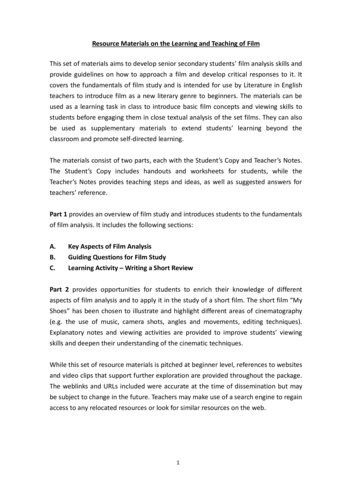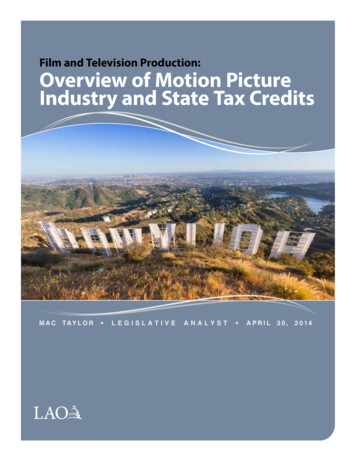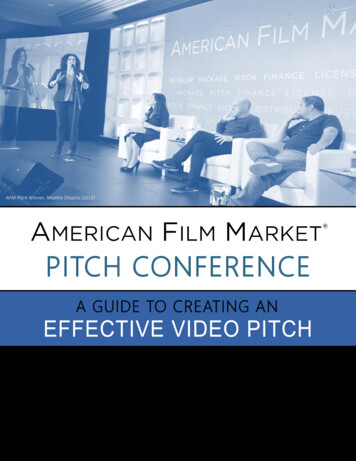
Transcription
1AFM Pitch Winner, Maddie Shapiro (2018)PITCH CONFERENCEA GUIDE TO CREATING AN
2 AFM Guide to Creating an Effective Video PitchTable of ContentsOverview3Types of Pitches Accepted3Submission Schedule3Develop Your Video Pitch ScriptVideo Pitch Structures44Rehearse and Record Your Video Pitch5Submit Your Pitch to AFM8Selection Criteria9Appendix: Technical Instructions10If You Have Technical Difficulties 10Create A Google Account11Create A Pitch with Your Video Camera14Create A Pitch with Your Smartphone18
3 AFM Guide to Creating an Effective Video PitchOverviewThe AFM Pitch Conference is designed to give attendees a chance to watch film scriptpitches in action and learn how to effectively pitch ideas themselves. Last year, over 1billion in deals closed at the American Film Market to finance and purchase independentfilms from around the world. In the past, a number of film projects have gained traction andwent on to sell based on panelists and audience members hearing these pitches for the firsttime at AFM.The Pitch Conference is structured in the following way: Each selected pitcher has EXACTLY two minutes onstage to pitch their film script ideato a panel of distinguished producers. The panelists then take three minutes to provide an honest critique. If you are selected to pitch at the 2019 Conference, you will be heard by an audienceof over 600 people, mostly industry professionals.To be considered to pitch onstage at the AFM Pitch Conference on November 9, 2019,you will need to submit a 2-minute video pitch by October 18, 2019.What types of pitches are accepted? Narrative feature film scripts in any genre Long-form television scripts in any genreSubmission Schedule October 18, 2019: Video Pitch submission deadline October 28, 2019: Email Notification of selection to pitch onstage November 9, 2019: AFM Pitch Conference, 9:15 AM- 12:45 PM PST
4 AFM Guide to Creating an Effective Video PitchDevelop Your Video Pitch ScriptYour 2-minute video must answer three questions: What’s your name? What’s the genre and tone of your project? What’s your project about?Video Pitch StructuresIt’s completely up to you to determine the best way to pitch your project. That said, here area few video pitch structures you can contemplate to help you answer the three questions:THE CLASSIC PITCH:“Hi, my name is [NAME]. My project is a [GENRE] in the veinof [TONALLY SIMIILAR PROJECT]. It’s called [TITLE] and it’sabout [LOG LINE]. The project continues to follow [MAINCHARACTER AND SUPPORTING CHARACTER] as they [SECOND ACTACTIVITY]. Problems occur when [MIDPOINT COMPLICATION ORSECOND ACT LOW POINT]. Now they must [THIRD ACT STRATEGY] orface [CONSEQUENCES].“THE PIXAR PITCH:“Hi, my name is [NAME]. I’m a [OCCUPATION] and I live in[LOCATION]. My project is a [GENRE] called [TITLE]. Once upon atime. Every day. One day. Because of that. Because of that. Until finally.”THE BLAKE SNYDER PITCH:“Hi, I’m [NAME] and I’m from [LOCATION]. On the verge of a[STASIS DEATH] moment, a flawed hero [BREAKS INTO TWO]with the [B-STORY], but when the [MIDPOINT] happens, he/shemust learn the [THEME] before [ALL IS LOST] to defeat the[OBSTACLE/ANTAGONIST].”
5 AFM Guide to Creating an Effective Video PitchAs you can see, pitch structures make use of screenplay beats; and as you know, there arevarious guides to what these beats are. The beats in the “Classic Pitch” above are fromscreenwriting instructor Pilar Alessandra. For more information about Pilar’s definition ofscreenplay beats, check out her book: The Coffee Break Screenwriter. The beats in the “BlakeSnyder Pitch” above are, as you might guess, from screenwriting instructor Blake Snyder. Formore information about how Snyder defines the beats of a screenplay, check out his bookSave The Cat! For additional insight on the “do’s” and ”don’ts” of pitching to a room ofproducers and studio executives, you can also review Author Stephanie Palmer’s Ten Tips forPitching Your Film Successfully.Rehearse and Record Your Video PitchIn order to effectively deliver a pitch on camera, you have to rehearse. There’s somethingabout pitching out loud that helps you notice problem areas, clarify sentence structure, andfix any components of the pitch that might not be working.Remember as uncomfortable as you might be watching yourself on video and pitching toan empty room at first, judges can always tell the difference between someone who haspracticed their pitch and taken the time to rehearse before submitting their video and/orpitching live onstage. Here are some tips and suggestions related to creating and rehearsingyour video pitch:Step 1: Choose Your Ideal ListenerNo matter what subject is, pitching to camera can be challenging. To make it easier, identifya person in your life, who’s not only a member of your project’s target market, but someoneyou’d feel comfortable delivering your video pitch to. To be clear, this person does notneed to be in the actual room when you’re pitching. This is someone you’ll imaginelistening to your pitch while you practice. The idea is to replicate the kind of comfortableand conversational style you’d have with a friend. When the camera starts rolling, look intothe lens and start speaking to the person you feel most comfortable with.
6 AFM Guide to Creating an Effective Video PitchStep 2: Read Out LoudStart by reading aloud while you’re looking at your actual pitch notes. Read it a few times and time yourself. You’ll start to realize if you’re running over two minutes and you’ll be ableto make sentences shorter or more concise, as needed. You’ll also find areas that soundmore natural when expressed as sentence fragments, rather than a complete sentences.Step 3: Write on NotecardsWrite out your pitch on notecards - one paragraph on one side of the notecard and on thereverse side, you can write a header for the paragraph or the first few words as a mentalmarker.Step 4: Memorize and ReviseThoroughly memorize your text and keep polishing! Cross out words, underline where youwant emphasis, and add any other notes that might help you during the pitch.Step 5: Rewrite NotecardsNow that you’ve honed your pitch, rewrite the text on brand new notecards so the copy isclean. The act of writing out your script can be hugely helpful in memorizing it.Step 6: Pitch to CameraDeliver your pitch on camera. Remember to visualize the person you chose in Step 1, theperson to whom you can pitch most casually and comfortably.Step 7: Watch YourselfWe know. It’s painful. But try to observe where you speak too quickly, where you may needto vary your tone, and where you need to improve on eye contact. Reading word-for-wordfrom notecards is one of the fastest ways to come across as being ill-prepared onstage.Step 8: Pitch To Camera Ten TimesPitch to camera ten times in a row. This might sound a little mind-numbing, but after the firstfive times, you’ll get so bored that something magical will start to happen—you’ll know yourscript well enough to improve your performance without having to “do” anything.
7 AFM Guide to Creating an Effective Video PitchStep 9: Record Your Polished PitchBy this point, you’re ready for “Action!”Record your video pitch and follow the instructions below to submit it for consideration.PLEASE NOTE: Our Complete Guide to the process of submitting your video pitch for the2019 AFM Pitch Conference will be sent to you following your purchase of an official Platinum,Executive Plus, or Industry Plus Badge; or following the purchase of an individual ticket to theAFM Pitch Conference on 11/9/2019.
As you can see, pitch structures make use of screenplay beats; and as you know, there are various guides to what these beats are. The beats in the "Classic Pitch" above are from screenwriting instructor Pilar Alessandra. For more information about Pilar's definition of screenplay beats, check out her book: The Coffee Break Screenwriter.

